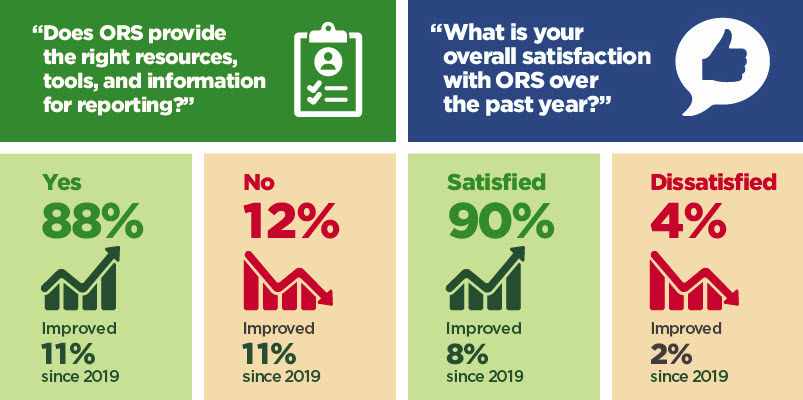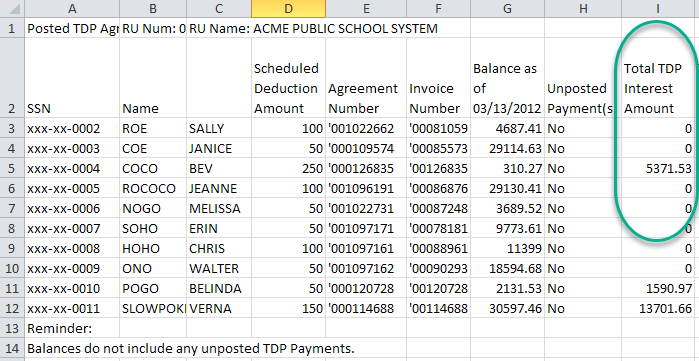 We have analyzed the results of the 2020 Employer Survey conducted in March. To those who responded, thank you for your valuable feedback.
Compared to the 2019 survey, there was small but significant positive movement in your responses to several questions, and no questions with significant negative movement. Specifically, on the “ease of reporting” question, three tasks saw improvement of more than 2% (more respondents rating the task easy and fewer rating it difficult compared to 2019).
New hire reporting remains the task rated most difficult, but the number of people rating it difficult dropped by 5.3%. Two other specific tasks — pay cycle reporting and summer spread wages — were also rated easier.
 The 2020 survey shows significant improvement on two other questions as well. In response to the question “Does ORS provide the right resources, tools, and information for reporting?” 88% answered yes – an 11% improvement over last year. In response to the question about overall satisfaction with ORS, 90% answered yes – an 8% improvement over last year.
Lastly, your comments revealed that the newsletter, introduced about 15 months ago, has been very well received. You describe the newsletter as “a great addition,” “extremely valuable,” and “super informative.”
ORS sincerely appreciates the time many of you took to provide us with feedback. We continue to review all your comments for insights into possible process improvements. We take your concerns into consideration as we consider how to balance your needs with those of the retirement system, as well as legal and legislative requirements. You are essential partners in our goal of providing public school employees with a secure retirement.

Now that the school year has ended, many reporting tasks shift toward summer activities, when employees may be retiring or terminating, or in preparation for hiring new employees. An updated End of School Year Checklist is now available on the PSRU to use as a reminder of these tasks.
End of School Year Checklist – 2020
|

As a reminder, employees with Tax-Deferred Payment (TDP) agreements will receive an interest update in July.
TDP agreements that were initiated on or after January 1, 2004, are subject to 8% compound interest, applied annually on July 1 to the unpaid balance. This is included in terms of the completed TDP Agreement Form (R0392C).
As the employer, it's your responsibility to update the employee’s remaining TDP balance with the TDP Interest each year after July 1. The amount appears in the Total TDP Interest Amount column of the TDP Agreement Details spreadsheet.
 See RIM sections 10.06: How to Use the TDP Download Detail Link and 10.07: TDP Annual Interest in the Reporting Instruction Manual for more information.

Voya Financial focuses on helping public school employees access their accounts and maximize their retirement benefits offered by the state. Voya has recently updated the New Employee Orientation tutorial. This tutorial takes about twenty minutes and is valuable to any employee new to public school employment.
The tutorial describes the State of Michigan 401(k) and 457 Plans in general, and the Pension Plus 2 and Defined Contribution retirement plan options in detail. It also discusses the importance of understanding available options and making a decision by the deadline. Please share this link to the tutorial with your new employees: https://www.brainshark.com/Voya/MPSERSNEO
ORS strongly encourages a conversation with Voya to discuss education opportunities for your new employees. You can schedule virtual sessions with a live presenter at your individual school, district, ISD/RESA, or community college. Call Voya at 517-284-4422 to discuss options and schedule sessions.

The annual GASB report (Schedules of Employer Allocations and Amounts for FYE Sept. 30, 2019) is currently being reviewed and audited by the Office of the Auditor General. The report and the data schedules (tables) needed for your own financial reports will be published on the Employer Information website (in the GASB section, under Administration and Compliance) by early July.
Your reporting unit will receive an email the day they are ready for download. Until you receive the email notification, please do not download tables from the GASB section of the Employer Information website. This will prevent inadvertently using last year’s tables. Most reports and tables for this year’s financial reports will refer to fiscal year ending Sept. 30, 2019.
Table 5, "Schedule of Covered Payroll by Employer” provides data based on the school fiscal year ending June 30, 2020. We expect to publish Table 5 by July 31.
There are no new issues involving GASB reporting for this year.
|

Every Detail 2 (DTL2) record requires both a wage code and an employment class code. The employment class code describes the type of work the employee does, such as teacher, custodian, coach, secretary, or data technician.
But some class codes should be used in specific situations, such as for someone receiving workers’ compensation or for certain types of overtime. Use these codes when they apply, instead of the regular one used for the employee. When an incorrect class code is used, you may have to make adjustments later.
Some employees may need two class codes on the same report. Use two DTL2 records to report the two positions this one employee performs. For instance, a teacher who is also a coach might receive a teaching salary (reported with employment class code 1240) and an hourly wage for coaching (reported with class code 1560).
Any MPSERS retiree that has returned to work should be reported with one of the retiree class codes (9003 – 9045). Please see our Reporting Retirees tool on the PSRU website to assist you determine which class code to use.
Some employment class codes can only be used with a specific wage code. Any restrictions like this are listed in the the Reporting Instruction Manual, sections 13.01: Detail 2 Employment Class Codes and 13.02: Detail 2 Wage Codes.
We suggest you review the full list of employment class codes in section 13.01, to remind yourself of some of the less common (but still important) codes. Following the list, the section provides definitions and other useful information for each code. Note that ORS employment class codes correspond to the Department of Education Salary Object Codes.
If you are uncertain about which employment class code to use, contact Employer Reporting at email us your question.
|
|